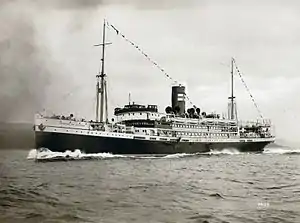Príncipe de Asturias (ocean liner)
Príncipe de Asturias was a steam ocean liner, built in Scotland for the Spanish Naviera Pinillos. She was launched in 1914 and wrecked in 1916 with the loss of at least 445 lives. She was the sister ship of Pinillos' 8,170 GRT Infanta Isabel, which was launched in 1912.
 Príncipe de Asturias | |
| History | |
|---|---|
| Name: | Príncipe de Asturias |
| Namesake: | Prince of Asturias |
| Owner: | Naviera Pinillos |
| Port of registry: | Cádiz |
| Route: | Barcelona – Buenos Aires |
| Builder: | Russell & Co, Port Glasgow |
| Yard number: | 663 |
| Launched: | 30 April 1914 |
| Maiden voyage: | 16 August 1914 |
| Fate: | ran aground & sank 5 March 1916 |
| General characteristics | |
| Tonnage: | 8,371 GRT |
| Length: | 460 ft (140 m) |
| Beam: | 58.2 ft (17.7 m) |
| Height: | 93 ft (28 m) |
| Installed power: | 8,000 horsepower |
| Propulsion: | two quadruple-expansion steam engines, two screws |
| Speed: | 18 knots (33 km/h) |
| Capacity: | 1,890 |
| Crew: | 200 |
| Notes: | sister ship: Infanta Isabel |
Príncipe de Asturias was the last ocean liner to be built in the UK for a Spanish shipping line. Thereafter the Sociedad Española de Construcción Naval (SECN) developed its shipyards to meet the Spanish merchant fleet's need for larger and more modern ships.[1]
The ship was named after the Prince of Asturias, the title of the heir apparent to the Spanish Crown. She is one of several ships to have been called Príncipe de Asturias. Others include a 44-gun frigate sunk in 1721, the former Acacia-class sloop HMS Iris, which was converted into a merchant ship in 1920 and sank in 1930, and the Spanish aircraft carrier Príncipe de Asturias, which was launched in 1982 and sold for scrap in 2015.
Building
Russell & Co built Príncipe de Asturias in its Kingston yard at Port Glasgow, Scotland, launching her on 30 April 1914.[2] Her sister Infanta Isabel had briefly been the largest ship in the Spanish merchant fleet. By the time Príncipe de Asturias had been built, Pinillos' main competitor, Compañía Transatlántica Española, had taken delivery of the larger liners Reina Victoria-Eugenia and Infanta Isabel de Borbón.
David Rowan & Co of Glasgow built Príncipe de Asturias' engines. They were twin quadruple-expansion steam engines driving twin screws.[2]
Route
In 1916 Príncipe de Asturias was assigned to the Barcelona – Buenos Aires route, with several intermediate ports of call, including Santos in Brazil.
Loss
Shortly before dawn on 5 March 1916, while trying to approach the port of Santos in dense fog, the ship ran aground on shoals about 3 nautical miles (5.6 km) east of Ponta do Boi on the island of Ilhabela, opening a huge hole in her hull.
Water entered her boiler room, causing some of her boilers to explode, and she lost power. The ship listed to starboard and soon capsized. She sank in five minutes, killing at least 445 of the 588 people aboard.
Only one lifeboat was launched, initially carrying 20 people. At the dawn and in the morning the lifeboat recovered more than 100 people. The French cargo ship Vega rescued 143 people, including the swimmer Marina Vidal and the only Brazilian on board, José Martins Vianna.
References
- Dunn 1973, p. 157.
- "Principe de Asturias". Scottish Built Ships. Caledonian Maritime Research Trust. Retrieved 13 November 2020.
Bibliography
- Dunn, Laurence (1973). Merchant Ships of the World in Colour 1910–1929. London: Blandford Press Ltd. ISBN 0-7137-0569-8.
- García Novell, Francisco (2009). Naufragio, la historia olvidada del Titanic español (in Spanish). Madrid: La esfera de los libros. ISBN 978-84-9734-881-2.
- Sella, Antoni; Martín, Rodrigo (2002). Vapores (in Spanish). Barcelona: Angle editorial. ISBN 84-88811-99-3.
- Silvares, José Carlos; Heinde Aranha Moura; RLuis Felipe (2006). Príncipe de Asturias: O Mistério das Profundezas. Magma Editora Cultural.
External links
| Wikimedia Commons has media related to Principe de Asturias (ship, 1914). |
- "El "Titanic Español"". Naufragios.net (in Spanish). Archived from the original on 9 February 2010.
- "Lista de tripulantes supervivientes del naufragio del trasatlántico español Príncipe de Asturias". Naufragios.net (in Spanish). Archived from the original on 29 May 2009. – list of crew and passenger names
- "Naviera Pinillos". Mar y Barcos (in Spanish).
- Allen, Tony; Lettens, Jan; Flota, Klaus; Miller, Jon. "SS Principe De Asturias [+1916]". Wrecksite.eu.